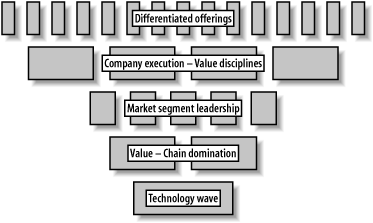Competitive Advantage
The fact that we can’t see the whole picture doesn’t mean we shouldn’t forge ahead. The disciplines of business strategy and information architecture are dauntingly abstract and complex. But we can’t fall victim to analysis paralysis. In the world of business, both disciplines are useless if they don’t contribute to the development of sustainable competitive advantage.
On this vital subject, business strategy can teach us one more lesson. In short, the invisible nature of our work can contribute to our competitive advantage. Geoffrey Moore reveals this hidden opportunity with respect to business strategy. In Living on the Fault Line, Moore presents a competitive-advantage hierarchy to show the multi-layered foundation upon which strategy is built (Figure 18-7).

Figure 18-7. A competitive-advantage hierarchy
Moore explains that while most people focus on the top layer of differentiated offerings (e.g., branding and positioning), businesses can achieve lasting competitive advantage only by building from the bottom up.
At the base lies the technology itself, the core of cores. On top of it form value chains to translate its potential into actuality. Atop this evolution lie specific markets . . . Within all markets, companies compete against each other based on their ability to execute their strategy . . . The ultimate expression of this competition, the surface ...
Get Information Architecture for the World Wide Web, Second Edition now with the O’Reilly learning platform.
O’Reilly members experience books, live events, courses curated by job role, and more from O’Reilly and nearly 200 top publishers.

